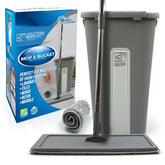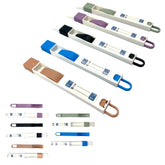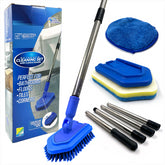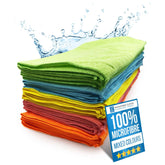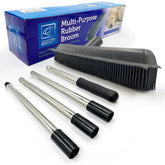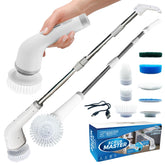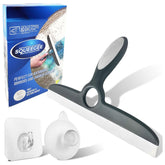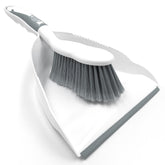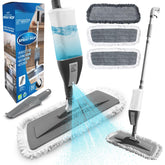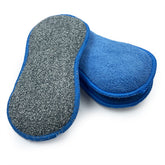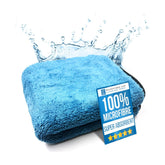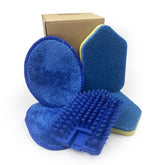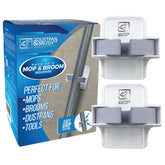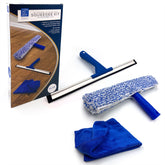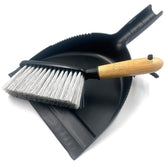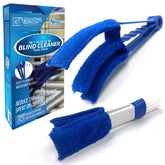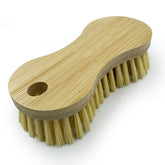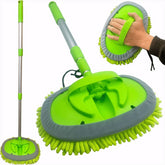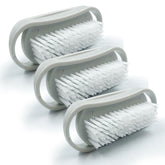How to Get Rid of Mildew on Surfaces

Whether you find in the form of yellow stains on walls, powdery spotting on wood furniture or black gunk in the corners of the shower, most of us have had a problem with mildew at some point…
Mildew is a type of mood that thrives in damp, moist places. It will cling to fabric, walls, tiles and wood, basically anywhere it can! It also loves to hide in neglected spots like garages, attics, under the sink, behind appliances etc, basically anywhere that traps moisture and has some humidity levels.
Besides the ugly black stains it leaves behind, if mildew is left untreated it can trigger health problems such as allergies, breathing problems and generally diminishes the indoor air quality in your home. While most mildew is also visible, you may start to smell musty odours and start sneezing or itching as well.
It’s ideal to prevent mildew before it starts (we’ll give you some tips soon for this!), but don’t stress if you already have a situation. This blog post will telly everything you need to know about how to get rid of mildew from every corner of your house!
Mildew vs Mould
Although it’s less dangerous that other types of mould, for example black mould, it can still cause health problems and damage to your home. Mildew is normally quite visible in the early stages and pops up as white or grey powdery dots and generally remains fairly flat. Mould is darker in appearance and is often in shades of black, red, green and have a fuzzy like texture. Whilst mould and mildew can both be taken care of in similar ways, mould is definitely the more stubborn out of the two!
How to PREVENT mildew
- Open your bathroom door during and after showering to allow moisture out. (This may be for just those that live on their own…)
- Dry or squeegee your shower walls, floors and tubs after showering to remove excess moisture and help surfaces dry faster.
- If you have tiles in your bathroom, seal the grout lines every year to help waterproof the surface.
- Don’t leave damp towels on the floor.
- Don’t leave gym/sports clothes in bags or wardrobes…
- Track down and fix leaks as soon as you possibly can.
What you’ll need to get rid of mildew
- A good grout brush like:
- Rubber gloves
- Bleach
- Mould & Mildew remover spray
Walls and Grout
Mildew can very quickly take root on walls and on your grout, especially in the bathroom where ventilation is poor. It’s important to stop the growth as soon as possible and here’s how:
- Mix 1/4 bleach to 3/4 water in a bowl (multiply this if more is needed)
- Apply the mixture with a soft scrub brush for walls or the stiff grout brush for the grout
- Leave the solution for 15 minutes to sink into the mildew
- Once left for 15 minutes scrub at the area with your grout brush
- Rinse the area and wipe dry.
- Repeat this step if you still find some areas have some mildew left.
Shower Curtains
If you step into the bath and notice that your shower curtain is dotted with mildew take action ASAP! (One way to help avoid this is to spread your shower curtain to help it dry quicker)
- Wash your shower curtain in the washing machine with your regularly laundry products on a gentle cycle. Add a few bath towels to help the cleaning process with extra cleaning agitation.
- Hang the curtain out to dry or place in the tumble dryer on low for a few minutes to remove excess liquid.
Clothing
If you’ve stored your winter clothes away in the attic or basement for the season you may notice a mildew smell and mould stains, but don’t worry! Your clothes aren’t ruined, they just need a little TLC.
- Use a stiff brush (similar to our grout brush) to remove the mildew spores using some warm water and white distilled vinegar, preferably outside. Or submerge the clothing entirely in the solution and let soak.
- For more stubborn stains check the care label to see if it’s safe to use chlorine bleach on your clothing. If so pre soak the clothing in the black for about 30 minutes.
- Hang the clothing on the washing line and let them dry and the stains should have gone.
Washing Machines
Even though washing machines sole reason is to clean things, they can get dirty themselves and harbour mildew without you knowing! Mildew can grow within the rubber gasket if you’re not frequently cleaning your washing machine.
- Peel back the rubber gasket and scrub the area with with 1/4 bleach to 3/4 warm water using a microfibre cloth or soft bristled brush. Remove the liquid by using either a dry microfibre cloth or just kitchen rill to make sure all excess water has gone.
- Run a clean cycle on your washing machine with either a washing machine cleaner or two cups of white distilled vinegar on a hot cycle.The hot water-vinegar combo helps remove and prevent bacteria and mildew growth within the drum.
- Moving forward, make sure you regularly clean and dry your washer, and always pay close attention to the rubber gasket. You should always leave the washer door open after you’ve finished unloading so it will dry much faster.
Wood Surfaces
Mildew can grow on wooden cabinets, panelling and furniture if they’re exposed to moisture for too long.
- Vacuum the loose spores of mildew with the soft brush attachment as to not scratch your furniture.
- Clean small areas using a microfibre cloth that’s been dipped in in a solution of a dishwasher tablet and water. Make sure it’s well wrung before wiping.
- Rinse with a clean water dampened cloth and dry immediately after. Be careful not to over water or have the water too hot as the wood could warp or it could damage the finish.
- Finish by polishing it off and returning that shine!
Mattresses (and Sofas)
Not only is choosing the best mattress important for your sleep and health, but cleaning it is also critical to your health. When cleaning your mattress, you’re more than likely only cleaning the surface stains. Any mattress that’s been damaged by water or may have mildew growing inside should just simply be DISCARDED.
- Vacuum the entire mattress
- For the remaining stains, sponge the surface with a cloth dampened in 1 cup rubbing alcohol and 1 cup warm water. Do a spot test first to make sure this wont damage your fabric though.
- To rinse, wipe the mattress down with a slightly damp sponge or microfibre cloth.
- Fan dry the mattress for several hours if possible and sprinkle on and brush in some baking soda to help remove any bad odours.
- Spray the surface with disinfectant to kill any spore that could linger.


